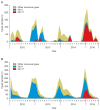Emergence of Norovirus GII.17-associated Outbreak and Sporadic Cases in Korea from 2014 to 2015
- PMID: 28443229
- PMCID: PMC5402847
- DOI: 10.24171/j.phrp.2017.8.1.12
Emergence of Norovirus GII.17-associated Outbreak and Sporadic Cases in Korea from 2014 to 2015
Abstract
Human norovirus are major causative agent of nonbacterial acute gastroenteritis. In general, genogroup (G) II.4 is the most prominent major genotype that circulate in human population and the environment. However, a shift in genotypic trends was observed in Korea in December 2014. In this study, we investigated the trend of norovirus genotype in detail using the database of Acute Diarrhea Laboratory Surveillance (K-EnterNet) in Korea. GII.17 has since become a major contributor to outbreaks of norovirus-related infections and sporadic cases in Korea, although the reason for this shift remain unknown.
Keywords: genogroup II.17; genogroup II.4; norovirus; outbreak.
Figures


Similar articles
-
Emergence of Norovirus GII.4 variants in acute gastroenteritis outbreaks in South Korea between 2006 and 2013.J Clin Virol. 2015 Nov;72:11-5. doi: 10.1016/j.jcv.2015.08.012. Epub 2015 Aug 28. J Clin Virol. 2015. PMID: 26356986
-
Molecular epidemiology of norovirus GII.4 variants in children under 5 years with sporadic acute gastroenteritis in South Korea during 2006-2013.J Clin Virol. 2014 Nov;61(3):340-4. doi: 10.1016/j.jcv.2014.08.018. Epub 2014 Sep 1. J Clin Virol. 2014. PMID: 25223918
-
Acute gastroenteritis outbreak caused by a GII.6 norovirus.World J Gastroenterol. 2015 May 7;21(17):5295-302. doi: 10.3748/wjg.v21.i17.5295. World J Gastroenterol. 2015. PMID: 25954103 Free PMC article.
-
Emergence of multiple norovirus strains in Thailand, 2015-2017.Infect Genet Evol. 2018 Jul;61:108-112. doi: 10.1016/j.meegid.2018.03.021. Epub 2018 Mar 26. Infect Genet Evol. 2018. PMID: 29597056
-
Molecular epidemiology of norovirus gastroenteritis outbreaks in New Zealand from 2002-2009.J Med Virol. 2012 Sep;84(9):1449-58. doi: 10.1002/jmv.23349. J Med Virol. 2012. PMID: 22825824
Cited by
-
The prevalence of non-GII.4 norovirus genotypes in acute gastroenteritis outbreaks in Jinan, China.PLoS One. 2018 Dec 28;13(12):e0209245. doi: 10.1371/journal.pone.0209245. eCollection 2018. PLoS One. 2018. PMID: 30592717 Free PMC article.
-
Norovirus GII.17 Associated with a Foodborne Acute Gastroenteritis Outbreak in Brazil, 2016.Food Environ Virol. 2018 Jun;10(2):212-216. doi: 10.1007/s12560-017-9326-0. Epub 2017 Nov 17. Food Environ Virol. 2018. PMID: 29150772
-
Epidemiology of Norovirus Outbreaks Reported to the Public Health Emergency Event Surveillance System, China, 2014⁻2017.Viruses. 2019 Apr 11;11(4):342. doi: 10.3390/v11040342. Viruses. 2019. PMID: 30979014 Free PMC article.
-
Nearly Complete Genome Sequence of a Human Norovirus GII.P17-GII.17 Strain Isolated from Brazil in 2015.Microbiol Resour Announc. 2019 Jan 31;8(5):e01376-18. doi: 10.1128/MRA.01376-18. eCollection 2019 Jan. Microbiol Resour Announc. 2019. PMID: 30714031 Free PMC article.
-
Phylogenetic characterization of norovirus strains detected from sporadic gastroenteritis in Seoul during 2014-2016.Gut Pathog. 2018 Aug 27;10:36. doi: 10.1186/s13099-018-0263-8. eCollection 2018. Gut Pathog. 2018. PMID: 30181781 Free PMC article.
References
-
- Kroneman A, Vega E, Vennema H, et al. Proposal for a unified norovirus nomenclature and genotyping. Arch Virol. 2013;158:2059–68. doi: 10.1007/s00705-013-1708-5. https://doi.org/10.1007/s00705-013-1708-5. - DOI - DOI - PMC - PubMed
-
- Park K, Yeo S, Jeong H, et al. Updates on the genetic variations of norovirus in sporadic gastroenteritis in Chungnam Korea, 2009–2010. Virol J. 2012;9:29. doi: 10.1186/1743-422X-9-29. https://doi.org/10.1186/1743-422X-9-29. - DOI - DOI - PMC - PubMed
-
- Cho HG, Lee SG, Kim JE, et al. Molecular epidemiology of norovirus GII.4 variants in children under 5 years with sporadic acute gastro-enteritis in South Korea during 2006–2013. J Clin Virol. 2014;61:340–4. doi: 10.1016/j.jcv.2014.08.018. https://doi.org/10.1016/j.jcv.2014.08.018. - DOI - DOI - PubMed
-
- de Graaf M, van Beek J, Vennema H, et al. Emergence of a novel GII.17 norovirus – End of the GII.4 era? Euro Surveill. 2015;20 doi: 10.2807/1560-7917.ES2015.20.26.21178. https://doi.org/10.2807/1560-7917.ES2015.20.26.21178. - DOI - DOI - PMC - PubMed
-
- Korea Centers for Disease Control and Prevention. Guideline for water and foodborne diseases prevention and control. Chungju: Korea Centers For Disease Control and Prevention; 2016.
LinkOut - more resources
Full Text Sources
Other Literature Sources

